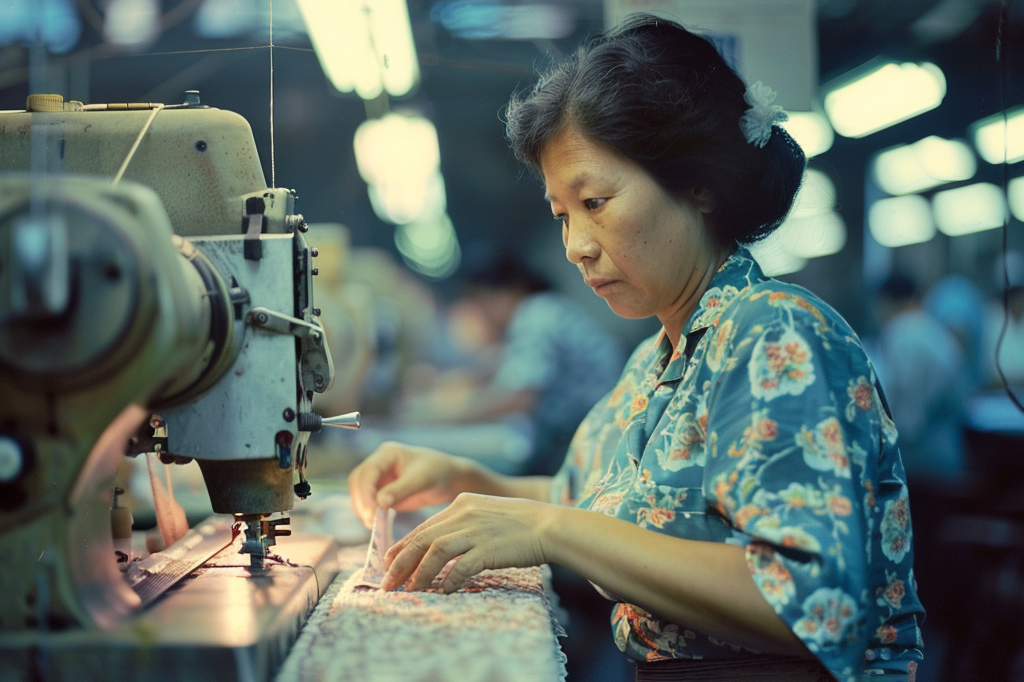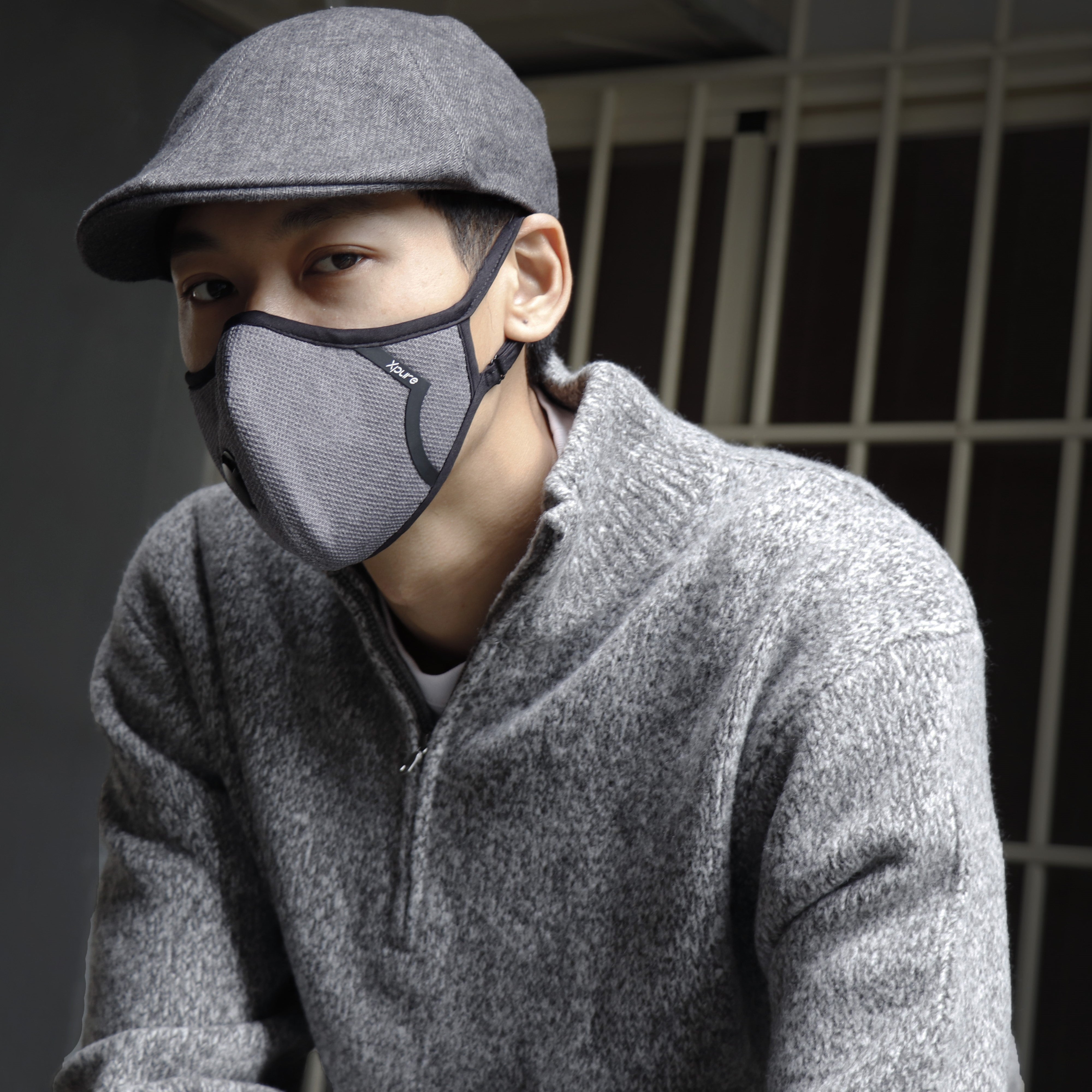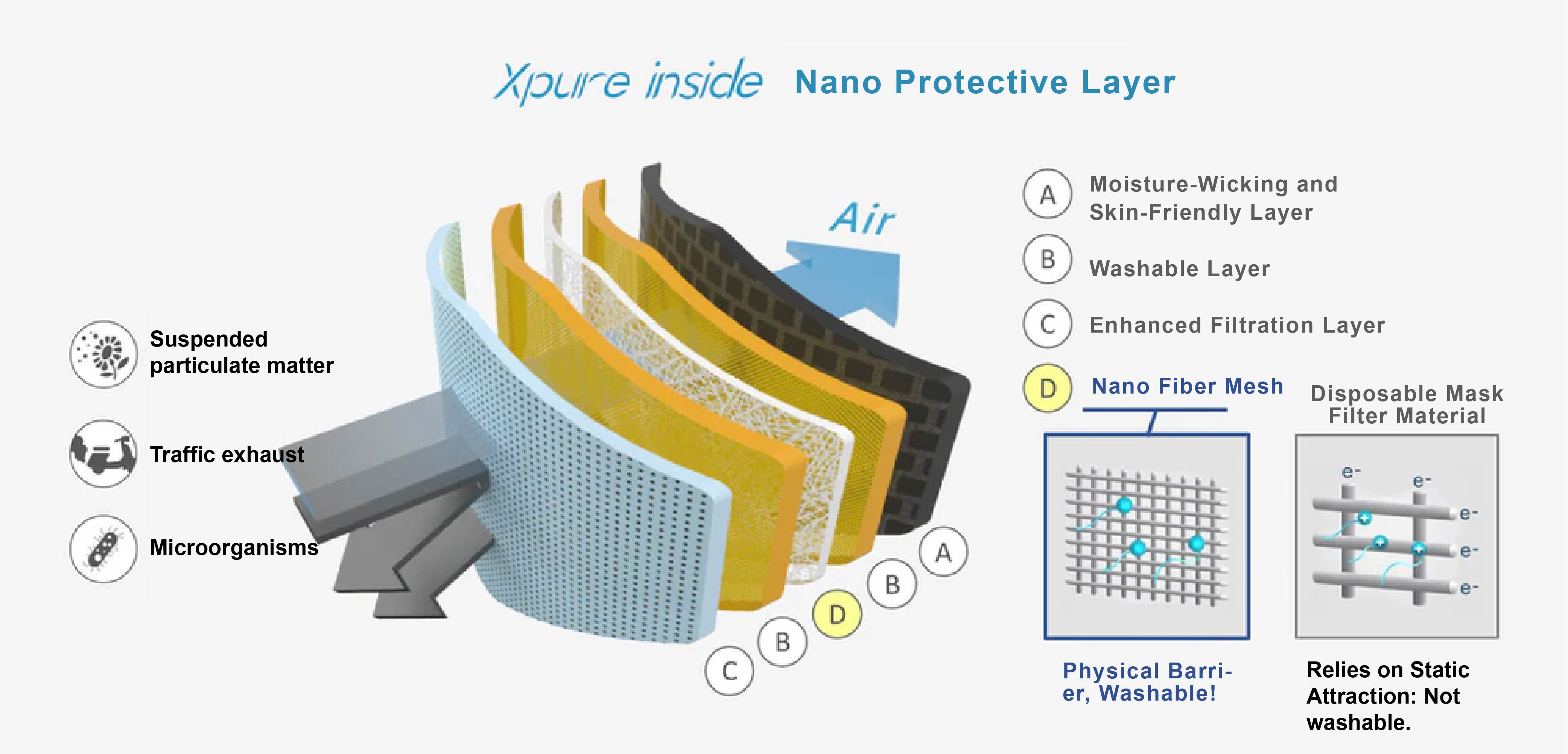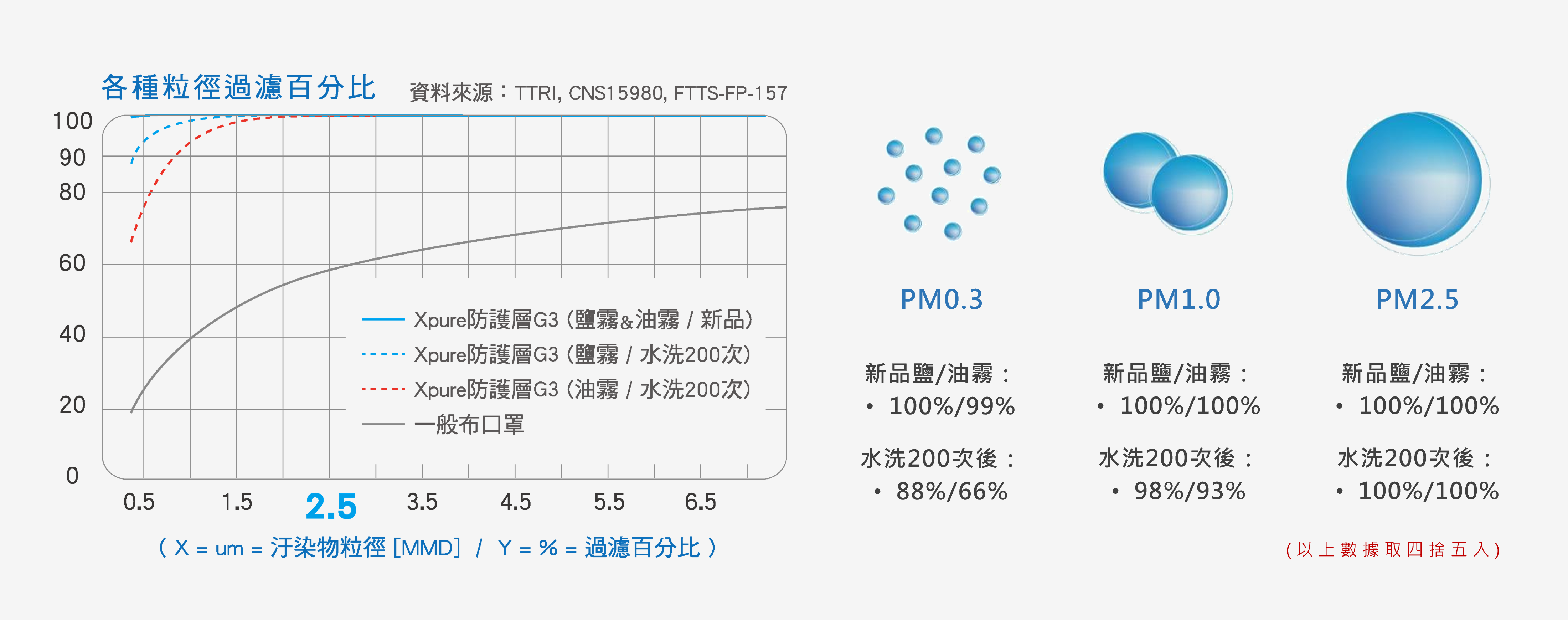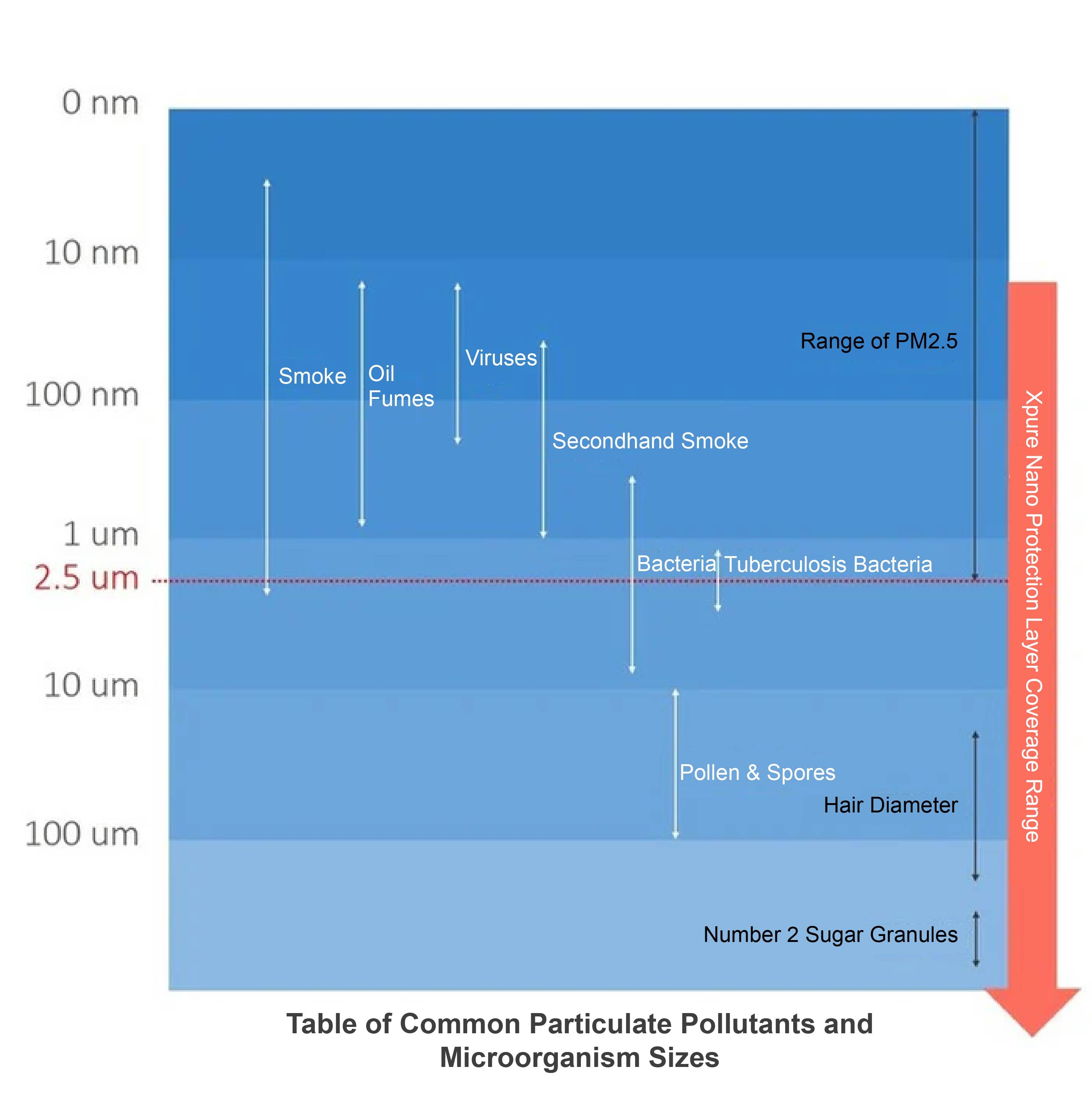Xpure Inside core filtering technology
【Xpure Nano Protective Layer】
Introduction to multi-layer structure
nanofiber mesh
It provides "physical defense" with an extremely fine mesh structure. Compared with the "electrostatic adsorption type" melt-blown non-woven fabric commonly used in general disposable masks, the nanofiber mesh does not rely on static electricity, is not afraid of water, is stable in nature, and is virtually invisible. Shelf life and other advantages.
Double washable layer
The nanofiber mesh is covered up and down to provide physical strength and good water repellency, and can withstand multiple water impacts and scrubbing.
Moisture-wicking skin-friendly layer
High breathability and high moisture absorption and perspiration capabilities make the breathing process dry and comfortable.
Full particle size filter map analysis
Since there is currently no clear specification in the world to define what "effective anti-PM2.5" is, and there is no lower limit on the size of PM2.5 (as long as it is less than 2.5 microns, even pollutants as small as radiation dust are considered within it). Therefore, we conducted a full-range particle size scan based on the maximum particle size of existing machines to faithfully present the filtration capabilities of [Xpure Nano Protective Layer] for consumers’ reference and choice.
In addition, the government’s latest national standard for anti-haze (PM2.5) mask testing, CNS15980, promulgated by the government in 2017, is currently the most complete and rigorous specification for anti-PM2.5 masks in Taiwan. Net convection anti-haze fabric masks have also passed various tests of CNS15980. Please click here to view the relevant test report.
For the protection of germs, the Xpure nano protective layer has also passed the BFE (bacterial filtration efficiency), VFE (virus filtration efficiency), and PFE (particle filtration efficiency) tests of the American ASTM standards, with results of greater than 99.5% in all three tests. Related tests Please click here to view the report.
*Note: PM2.5 is the general name for all types of airborne particles with a geometric mean diameter (MMD) below 2.5 um, including PM1.0 (MMD=1.0um), PM0.3 (MMD=0.3um)...etc. Because it cannot be blocked by human alveoli, it easily invades the bloodstream and has a significant impact on human health. It is an internationally recognized first-level carcinogen.
Recommended frequency and method of cleaning
The recommended number of cleanings is 200 times
Taking Xpure Nano Protective Layer G2 as an example, after cleaning 200 times, the filtration efficiency of PM0.3 dropped to about 80%, PM1.0 was still about 97%, and PM2.5 remained above 99%. Therefore, in fact, it is not that it will be completely ineffective after 200 times of washing. The reduction in filtration efficiency is gradual and slow. Instead, after 200 times of washing, the protective power will drop to the lower limit of the national anti-haze standard (CNS15980 new B level). At this time, there will still be a certain level of protection. However, it is still recommended to replace it with a new one to ensure the quality of breathing.
Recommended cleaning methods are gentle hand washing and gentle wringing.
If you use a washing machine to clean, please first put it in a laundry bag (underwear with a hard shell is better) and because you are not sure about the cleaning power of each washing machine, please set it to "soft wash". Neutral detergents (soap, laundry detergent, shower gel, etc.) can be used to assist cleaning. The drying method is the same as ordinary clothes. It can be air-dried. It is okay to be exposed to the sun. However, please avoid direct exposure to the sun for a long time in summer. When the temperature exceeds 80 degrees, it will begin to damage the filter material.
【Xpure Nano Protective Layer】
Filter range
【Xpure Nano Protective Layer】
Third party inspection report
National Standard Test Report (TTRI) on performance indicators and test methods of CNS15980 anti-haze (PM2.5) masks
KN95 (GB2626-2019) China Self-priming Filtering Particulate Respirator Test Report (Microtest)
Virus/bacteria/particle filtration test report according to ASTM standard of Nelson Lab in the United States (Nelson Lab, VFE/BFE/PFE)
CNS14774 National Standard Test Report (TTRI) for General Medical and Surgical Face Masks (TTRI)
American ASTM International General Medical Mask Standard Test Report (SGS, HK)
Washed 200 times - Filtration test report of different particle sizes (TTRI, FTTS-FP-157)
N95 test method filter test report (TTRI, CNS14755)
Anti-ultraviolet (UV) index test report (TTRI, UPF)
